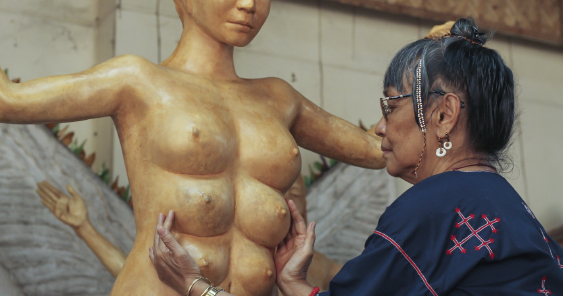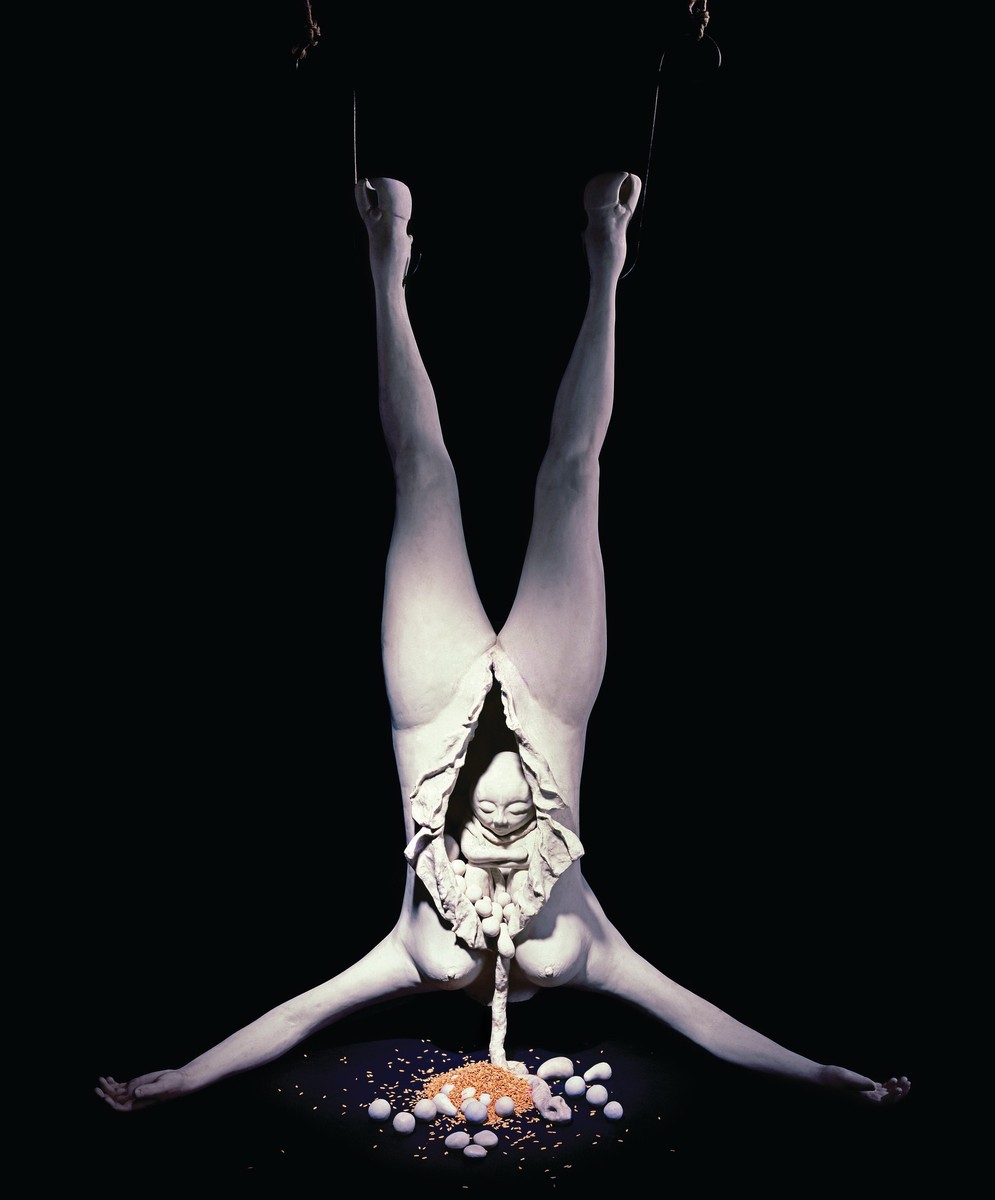Words by Rome Jorge
Photos by Edward Joson
One does not just see an Agnes Arellano sculpture. One is consumed by it, coursed through it intravenously, and birthed by it. Her art is both a visceral and spiritual experience.
Working often with her own body casts, she has sculpted mothers being split apart to reveal their womb and spilling fetuses and placenta or pregnant women birthing while half submerged in the earth.
Using materials such as tea-stained cold cast marble, bronze, clay, and plaster, she has made goddesses from mythologies across the globe into her own craven image: Kali the six armed Hindu goddess of destruction, the multi breasted goddess Inanna from Mesopotamia, and Dakini, the tantric priestess who carries the souls of the dead to the sky.
She calls her groupings of sculptures “inscapes”—a term she borrowed from the poetry of Gerard Manley Hopkins—where people do not just observe a sculpture’s facade but instead walk into it to explore the core of its meaning.
Backstories and true stories
In a correspondence with adobo magazine, Arellano enriches the experience of her art by revealing the events in her life that that provide context and subtext to her sculptures.

‘Innana’ tea-stained cold-cast marble, 2017
Fire and death are themes that repeat in Arellano’s works. “In ‘Penance of the Three Fires,’ I used my body cast to portray ‘The Lady (Anima)’, but I used the face of my brother Deo. An octave after the event, we had decided to do a ritual art exhibit to heal ourselves from the tragic death by fire of our parents and sister in 1981. In collaboration with an architect and a poet, we turned the fire-gutted 1,000 square meter property into a giant labyrinth with philosophical dead ends as one would face in life. Here we released all our pent-up grief and guilt and other emotions, ideas and misconceptions that were preventing us from moving on,” recalls Arellano.
Her sister Citas and her parents Otilio and Liwayway perished in a fire that razed the Arellano ancestral home in San Juan, Manila while Agnes was at a remote island in Spain in 1981. Otilio Arellano was an architect much like his grand uncle, the acclaimed Juan Arellano who designed historic landmarks such as the Metropolitan Theatre and Philippine National Museum (formerly the old congress) the Manila Central Post Office at Liwasang Bonifacio. On October 10, 1984, the Pinaglabanan Galleries was inaugurated at the site of Arellano ancestral home in memory of Agnes’ late parents and sister. In 1988 fire once again burned down the location once more, destroying its entire collection including Agnes’ own sculptures.
“In ‘Carcass-Cornucopia,’ the headless naked female body hanging by her hooves, was spurred by the pain and violence of my caesarian delivery. The horror of the experience was translated into no less than the birth of the universe by the explosion. Taking off from an ancient myth of creation, I recreate my body cast and make a new myth. The lordling bulol emerging from her belly is now the scion, the patriarchy waiting for his time as the matriarchal ‘herstory’ fades away. The inscape unfolds as the forms tumble out into cosmic shapes, an abundant heap of grain, then music, composed by skulls laid out on the floor,” explains Arellano.

Carcass Cournocopia cold-cast marble, 1987
“My own personal issue stemmed from a botched-up caesarian surgery; I had woken up in the middle of the night with the surgical hole in my belly spewing out blood and pus like a little fountain,” she confides. After her marriage to British investment banker, poet, and writer Michael Adams, Arellano gave birth on May 19, 1984 to her only child, Michelle Maria Celina—better known as acclaimed jazz vocalist Mishka Adams who now divides her time between London and Berlin.
Advocacies such as Reproductive Health are integral to Arellano’s art. “Many years ago I joined the traveling exhibition WOW.B, which used art as an educational tool for gender issues and reproductive rights: the exhibit title spelled out the show’s thesis: Who Owns Women’s Bodies?” she recalls.
Most recently, her inscape entitled “Project Pleiades” was a one several special presentations highlighted at the 2017 Art Fair. She reveals, “The issue of eligibility for priesthood is another sore point. In ‘Project Pleiades’ one of the four goddesses is Mary Magdalene. She was Jesus’ most beloved disciple but the male disciples, especially Peter, were jealous of her. The Church just cancelled her out after confusing us with several Marys, one of whom was a whore. As vindication, I gave her His wounds and portrayed her as pregnant with the fruit of their union.”
With Agnes Arellano’s art, women have reclaimed their divinity. Hail holy queen.
This article was published in the adobo magazine Gender 2017 issue.







